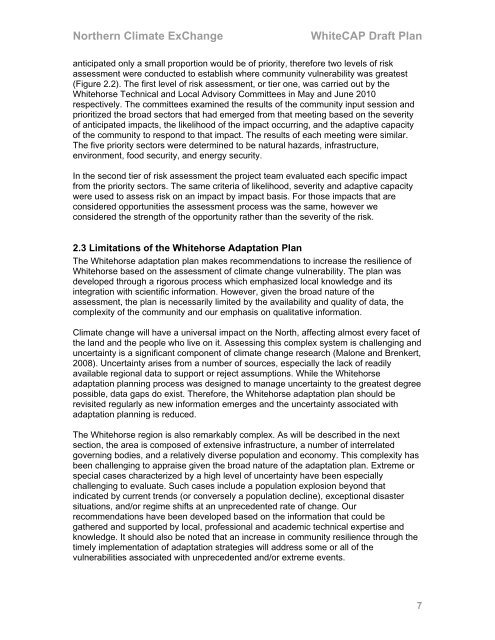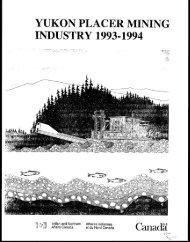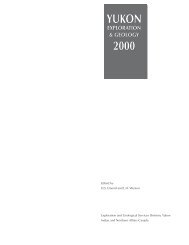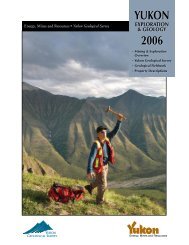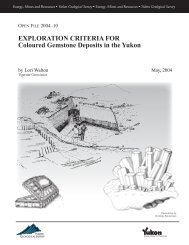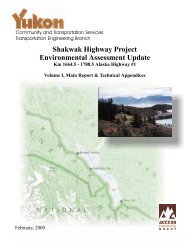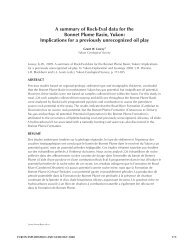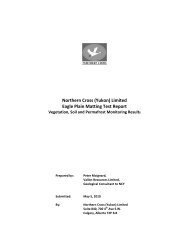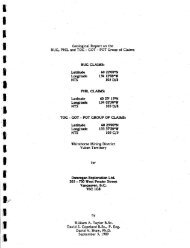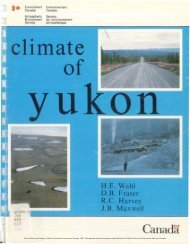WhiteCAP_Plan_01SEPT..
WhiteCAP_Plan_01SEPT..
WhiteCAP_Plan_01SEPT..
Create successful ePaper yourself
Turn your PDF publications into a flip-book with our unique Google optimized e-Paper software.
Northern Climate ExChange <strong>WhiteCAP</strong> Draft <strong>Plan</strong><br />
anticipated only a small proportion would be of priority, therefore two levels of risk<br />
assessment were conducted to establish where community vulnerability was greatest<br />
(Figure 2.2). The first level of risk assessment, or tier one, was carried out by the<br />
Whitehorse Technical and Local Advisory Committees in May and June 2010<br />
respectively. The committees examined the results of the community input session and<br />
prioritized the broad sectors that had emerged from that meeting based on the severity<br />
of anticipated impacts, the likelihood of the impact occurring, and the adaptive capacity<br />
of the community to respond to that impact. The results of each meeting were similar.<br />
The five priority sectors were determined to be natural hazards, infrastructure,<br />
environment, food security, and energy security.<br />
In the second tier of risk assessment the project team evaluated each specific impact<br />
from the priority sectors. The same criteria of likelihood, severity and adaptive capacity<br />
were used to assess risk on an impact by impact basis. For those impacts that are<br />
considered opportunities the assessment process was the same, however we<br />
considered the strength of the opportunity rather than the severity of the risk.<br />
2.3 Limitations of the Whitehorse Adaptation <strong>Plan</strong><br />
The Whitehorse adaptation plan makes recommendations to increase the resilience of<br />
Whitehorse based on the assessment of climate change vulnerability. The plan was<br />
developed through a rigorous process which emphasized local knowledge and its<br />
integration with scientific information. However, given the broad nature of the<br />
assessment, the plan is necessarily limited by the availability and quality of data, the<br />
complexity of the community and our emphasis on qualitative information.<br />
Climate change will have a universal impact on the North, affecting almost every facet of<br />
the land and the people who live on it. Assessing this complex system is challenging and<br />
uncertainty is a significant component of climate change research (Malone and Brenkert,<br />
2008). Uncertainty arises from a number of sources, especially the lack of readily<br />
available regional data to support or reject assumptions. While the Whitehorse<br />
adaptation planning process was designed to manage uncertainty to the greatest degree<br />
possible, data gaps do exist. Therefore, the Whitehorse adaptation plan should be<br />
revisited regularly as new information emerges and the uncertainty associated with<br />
adaptation planning is reduced.<br />
The Whitehorse region is also remarkably complex. As will be described in the next<br />
section, the area is composed of extensive infrastructure, a number of interrelated<br />
governing bodies, and a relatively diverse population and economy. This complexity has<br />
been challenging to appraise given the broad nature of the adaptation plan. Extreme or<br />
special cases characterized by a high level of uncertainty have been especially<br />
challenging to evaluate. Such cases include a population explosion beyond that<br />
indicated by current trends (or conversely a population decline), exceptional disaster<br />
situations, and/or regime shifts at an unprecedented rate of change. Our<br />
recommendations have been developed based on the information that could be<br />
gathered and supported by local, professional and academic technical expertise and<br />
knowledge. It should also be noted that an increase in community resilience through the<br />
timely implementation of adaptation strategies will address some or all of the<br />
vulnerabilities associated with unprecedented and/or extreme events.<br />
7


